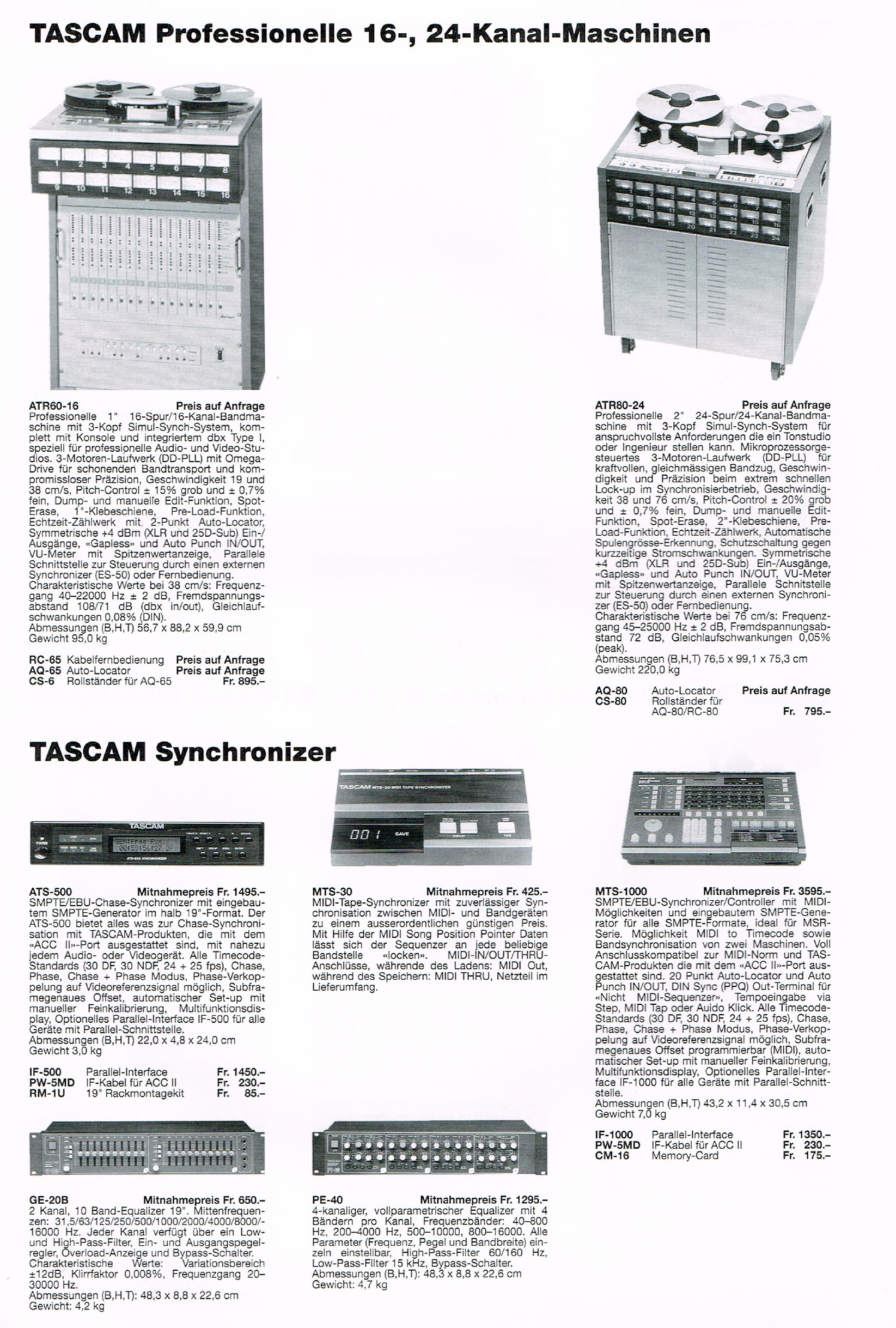Tascam ATR-60
Data
General
- Manufacturer: Tascam
- Model: ATR-60
- Type: Tape recorder
Version ATR 60/2 T: 2 channel, 1/4", 19/38 cm/sec, time code
- Version ATR 60-2 D: 2 channel, 1/4", 19/38 cm/sec DIN
- Version ATR 60-2 HS: 2 channel, 1/2", 38/76 cm/sec, High-Speed
- Version ATR 60-8: 8 channel, 1/2", 19/38 cm/sec
- Years of manufacture: 1984 - 1996
- Manufactured in: Japan
- Color: Black
- Dimensions (WxHxD):
- Drive: 482 x 461 x 310 mm
Amplifier: 482 x 105 x 268 mm
- Weight:
- Drive: 38 kg
- Amplifier: 7,5 kg
- New prices:
- Version ATR 60/2 T: 12'637 DM
- Version ATR 60-2 D: 9'283 DM
- Version ATR 60-2 HS: 15'790 DM
- Version ATR 60-8: 14'575 DM
- Version ATR 60-16: 26'220 DM
Technical Data
Mechanical
- PLL Servo Direct Drive Capstan Motor
- Fully compatible with SMPTE time code systems
- Precision real-time tape counter
- No overflow on zero return and intersection seek
- Coil size max. 26.5 cm (10-1/2")
- Pitch control Coarse (±1.5%) and fine (±0.7%)
- Manual, Dump and Stop editing options for fast, convenient editing
- Non-magnetizable ceramic capstan axis
- Remote function control capability on 4 and 8 track models
- Synchronous speed variations (DIN, Peak, WTD):
- 76cm/s (30 ips); ±0.06%.
- 38cm/s (15 ips); ±0,08%
19cm/s (7.5 ips); ±0.09% * Audio Input/Output Audio input/output: XLR connector and RCH connector Time code input/output: XLR connector Tape CUE: mechanical and automatic (RTZ-STC)
Electrical
- Electronically balanced inputs and outputs
- Input/output level controls with CAL/UNCAL switches on 2- and 4-track models.
- Frequency response sync playback equals repro playback
- Low frequency compensation
- Tape flow level switchable between 320 nWB/m and 250 nWB/m
- Switchable NAB or IEC equalization for tape speeds 15ips and 7.5ips. AES equalization at 30 ips
- TIME CODE/MEMO selector switch for the time code track on the 60-2T. The time code track can also be used to record an analog signal for spoken remarks by selecting MEMO mode.
- Frequency response over all (0 VU):
- 30-ips; 40 Hz - 26 kHz, ±2 dB.
- 10-ips; 30 Hz-23 kHz, ±2 dB
- 7.5-ips; 30 Hz-20 kHz, ±2 dB
- Input/Output Balanced Unbalanced:
- Nom. Line Input 600 Ohm, +4dB 50kOhm-10dB
- Nom. Line Output 600 Ohm, +4dB 50kOhm-10dB
- Headphone output 100 mW/8
- Bias frequency 150 kHz
- Distortion factor 0.8% at 0-VU/1 kHz
- External voltage spacing:
- 70 dbA at 38cm/sec 107 dbA with dbx
70 dbA at 15 cm/sec, ??? dbA with dbx
Comments
- Other models in the same series:
- Tape Deck:
- Tascam 112
- Tascam 112 R
- Tascam 122 MKII
- Tascam 133
- Tascam 234
- Tascam Porta One
- Tascam Porta Two
- Tascam Porta 05
- Tascam 244 Portastudio
- Tascam 246 Portastudio
- [[Tape Machines:
- Tascam 22-4
- Tascam 32
- Tascam 34-B
- Tascam 38
- Tascam 42
- Tascam 48 OB
- Tascam ATR-60
- Tascam ATR-80-24
- Tascam MS-16
- Tascam 388
- Mixer:
- Tascam M 1 B
- Tascam MX 80
- Tascam M 06
- Tascam M 106
- Tascam M 208
- Tascam M 216
- Tascam M 224
- Tascam M 308 B
- Tascam M 312 B
- Tascam M 320 B
- Tascam M 512
- Tascam M 520
- Tascam M 600/32
- Tascam M 600/24
- Headphone amplifier:
- Tascam MH 40 B
- Peak display:
- Tascam MU 40
Pictures
- Excerpt from advertisement: Tascam ATR-60
Reports
- Report from "Tape Museum":
- TASCAM Series 60 - Similarities.
- The ATR 60 is built so that the drive and electronics are in two separate chassis (2-piece). This modular design allows the tape drive and electronics to be mounted in a standard 19-inch ELA equipment cabinet, in a portable 19-inch rack, or in a mounting console such as the TASCAM CS-65 or CS-650, CS-607 and CS-702 + 704.
- The ATR-60's turntable is an exceptionally reliable professional design. It is built on an extra heavy chassis that guarantees stable alignment and the most accurate tape running. The robust construction of the drive minimizes maintenance. The microprocessor control system guarantees smooth, fast and accurate tape running by controlling the two direct-drive coil motors and the phase-locked-loop capstan motor.
- Even when synchronized with other audio drives, film scanners or video systems, the ATR-60 has enough torque and accuracy to keep up with fast switching operations.
- Furthermore, the mechanical and electrical drive design protects the tape from "stretching" and other stresses, even during long hours of start/stop operation and fast switching.
- The ATR-60's electronics are built on plug-in printed circuits for easy service. The VU meter front panel swings out (forward) for quick access to all trim controls needed for routine adjustment. This method also allows better viewing of the VU meters during adjustment. The adjustment is just as easy to perform in the vertical as in the horizontal position of the unit.

